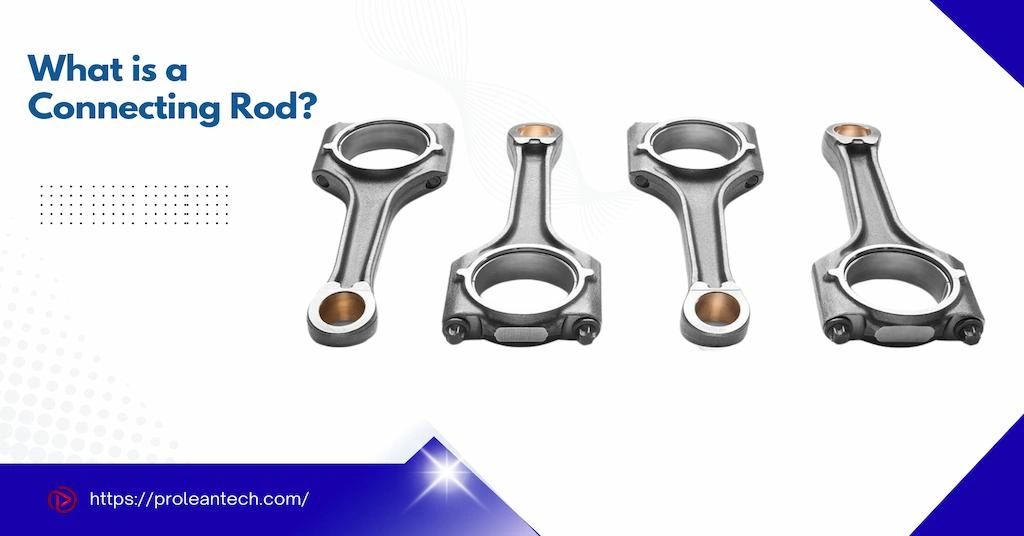
What is a connecting rod
What is a connecting rod? In simple terms, it is an engine component that converts the up-down motion of the piston into rotational motion. This is how exactly your car wheels run. The connecting rod converts the motion and transmits it to the crankshaft, the crank provides inputs for the gearbox, and the gearbox transmits to the driveshaft of your car.
Materials like carbon steel, aluminum, titanium, and steel alloy are used in connecting rod manufacturing. They can provide High strength, fatigue resistance, rigidity, and good wear resistance to sustain the continuous stress in the engine.
As a critical component in automotive engines (or any reciprocating engines), the connecting rod must be designed, manufactured, and finished with several considerations. So, let’s break this down into details.
What is a Connecting Rod?
Let’s start with the connecting rod definition: it is a structural link component that connects the piston with the crankshaft and converts the reciprocating motion of the piston into rotational motion. It carries cyclic tensile & compressive loads while resisting buckling and bending.
This mechanical component directly impacts the performance, vibration, and durability of the engine. Low strength and heavy rods reduce the torque output, and incorrect design and length can cause failure.
Furthermore, there are various connecting rod parts, like small end, shank, big end, metal bush, and crank pin.
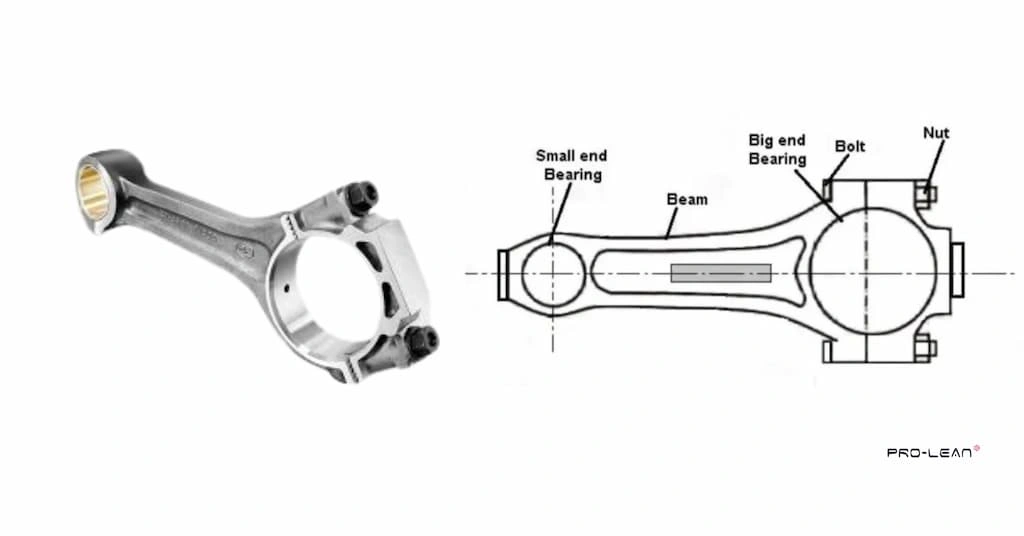
Parts of a connecting rod
- Small End Bearing: It is the smaller circular part that either contains a bushing or a roll bearing, and the gudgeon pin connects the piston and connecting rod at this end.
- Beam: It is also known as the shank or body, typically I or H-beam cross-section between two ends.
- Big End Bearing: The larger end that links the crankshaft with connecting rod. The outer cap is bolted together with a crank pin.
- Nut & Bolt: Fasteners that join the big end cap to the connecting rod body around the crank pin.
As the connecting rod is associated with the piston and crankshaft, Understanding Crankshaft Function & Cost Factors, and the characteristics of the piston is essential. So, optimizing the connecting rod, crankshaft, piston, and head components collectively helps to run the engine efficiently. If you are interested in learning more, read Enhancing Engine Performance with Cylinder Head Machining by clicking the link here.
How the Connecting Rod Works and Its Functions

Working of the connecting rod
The connecting rod involves two circular ends and a rod shank. The small end bearing connects with the piston, and the large end bearing with the crankshaft. The metal bush(roller bearing) on the small end of the bearing is linked with the piston through the gudgeon pin. On the other hand,
the big-end bearing is divided into two sections and bolted together with the crank pin of the crankshaft. Meanwhile, the bearing shells in the big end help to align it correctly with the piston.
As the piston moves downwards after combustion, connecting rods transmit the force at the crank pin at an angle. The offset of the crank pin converts the downward force into a rotational force as it is transmitted to the shaft. Then, the crank pushes the piston upward as it turns.
Besides motion conversion, other functions of connecting rods are;
- It withstands high tensile, compressive, and bending stresses.
- It aligns the piston and crankshaft by enabling a stable path for the piston.
- It reduces the vibration.
- The connecting rod also helps to achieve accurate engine timing and synchronization with the camshaft.
- As one of the power output components, optimized connecting rods contribute to engine efficiency.
Try Prolean Now!
What Are the Types of Connecting Rods?

Types of connecting rods
Since each type has certain specific features and use cases, it is essential to choose the right kind of connecting rod to get better performance and durability. The choice depends on end requirements for functionality, like weight limit, bending strength, and tensile strength.
You can find three types of connecting rods based on the cross section of the beam used in the shank: I-beam, H-beam, and X-beam.
Let’s elaborate on them further.
I-Beam Connecting Rods
The reason behind this name is the I-beam cross-sections of the shank. These lightweight and cost-effective rods are simple in design, but provide good fatigue, tensile, and compressional strength. Therefore, I-beam connecting rods are used in various brands of motorcycles, cars, and passenger vehicles. Besides IC engines, they are also suitable for other machinery and systems under 1000 horsepower.
H-beam Connecting Rods
In the H-beam, one beam across the middle of two vertical beams resembles an “H” shape. This geometry makes the connecting rod heavier, more rigid, and stronger. H-beam connecting rods are good with extreme pressure, high RPMs, and torsional load. But, in case of any misalignment, the bearings need to withstand higher loads.
These are typically used in high performance engines and heavy machinery, including industrial diesel engines, passenger cars, sport bikes, racing cars, turbcharged cars, and supercharged V8.
Furthermore, steel, titanium, or high-strength alloys are standard material options for H-beam connecting rods.
X-beam Connecting Rods
The X-shaped cross-section allows you to leverage the benefits of both I & H beams. This design reduces the weight but still offers high strength, crack resistance, and flexibility. You can use them in high-performance and efficient engines. Additionally, they are suitable for low rpm and high torque requirements.
Some typical use cases of X-beam connecting rods are racing engines, high-end cars, and custom diesel engines.
Connecting Rod Materials
Since the connecting rod can alter the operation and efficiency of the vehicle (or system), the material must be chosen carefully. You can compare the physical & mechanical properties, machinability, and cost of available options to select the optimal material for your requirements.
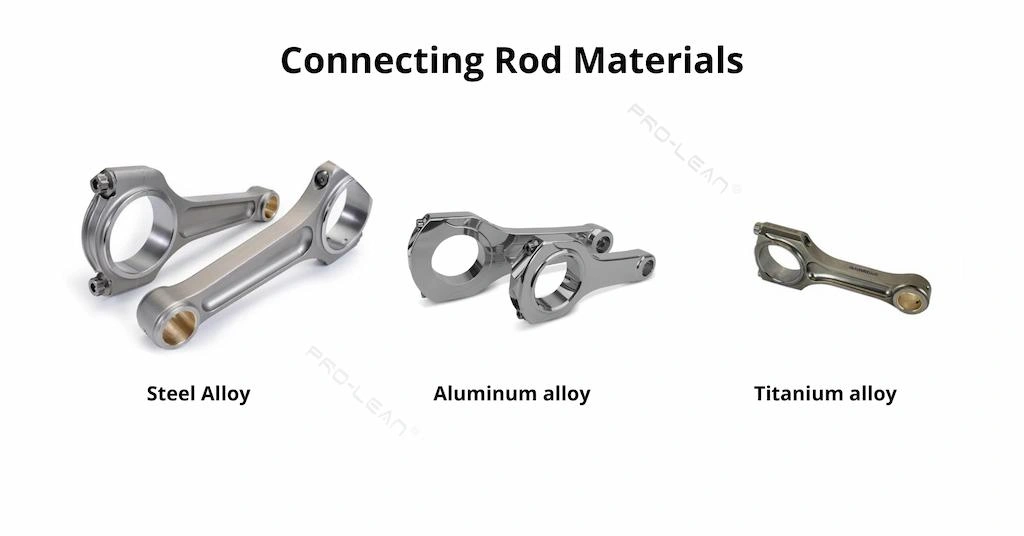
Connecting rod materials
The common rod materials are steel, steel alloys, cast iron, aluminum alloys, and titanium. The table below illustrates their key characteristics and application examples.
| Material | Key properties | Application examples |
| Steel (42CrMo4, 4340) | Excellent strength, fatigue resistance, good stiffness, and reliability. | Diesel passenger cars, light commercial engines, and motorcycles. |
| Steel Alloy (C70, 38MnVS6) | Good strength–cost balance, precise big-end alignment, good volume engines. | Modern passenger cars, custom machinery & systems. |
| Ductile Cast Iron | Good strength, machinability, and low cost. | Used in low-specific-output engines, like agricultural machinery, generators, etc. |
| Austempered Ductile Iron (ADI) | Higher strength/toughness than standard ductile iron; improved fatigue, cost-effective. | Medium-duty engines, balancing fatigue & cost. |
| Aluminium alloys (618, 7075) | Reduces reciprocating mass; good thermal properties, lower fatigue than steel. | Sports motors, some motorcycles, racing cars. |
| Titanium alloy (Ti-6Al-4V) | High specific strength, good fatigue strength; withstands high RPMs, costly. | Top-tier racing supercars, heavy-duty machines, and high performance motorcycles. |
Try Prolean Now!
Methods for Connecting Rod Manufacturing
Once you choose the right connecting rod material, you need to decide which manufacturing method is most suitable. Sometimes more than one manufacturing process needs to be applied to enhance the results.
The common methods to manufacture connecting rods include forging, CNC machining, and Casting. Additionally, they might need surface finishing and heat treatment at the end.
- Forging
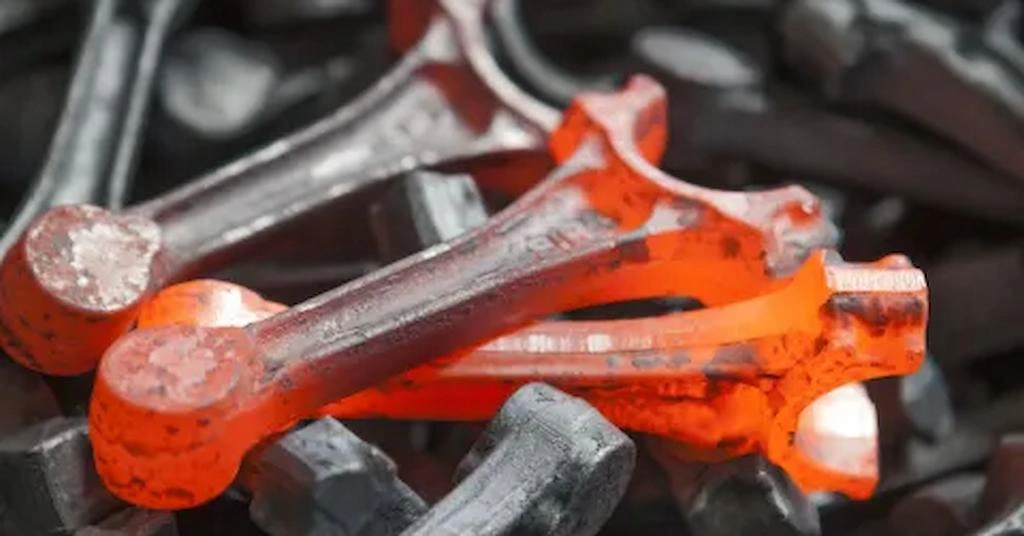
Forged connecting rods
In forging, aluminum or stainless billets are pressed inside a die having the shape of the desired connecting rod. Metals are also heated for better flow and grain structure in forged items. This method also improves the mechanical strength.
Sometimes forged connecting rods are further machined to achieve better accuracy and finish. They are suitable for heavy-duty loads like racing engines.
- CNC Machining
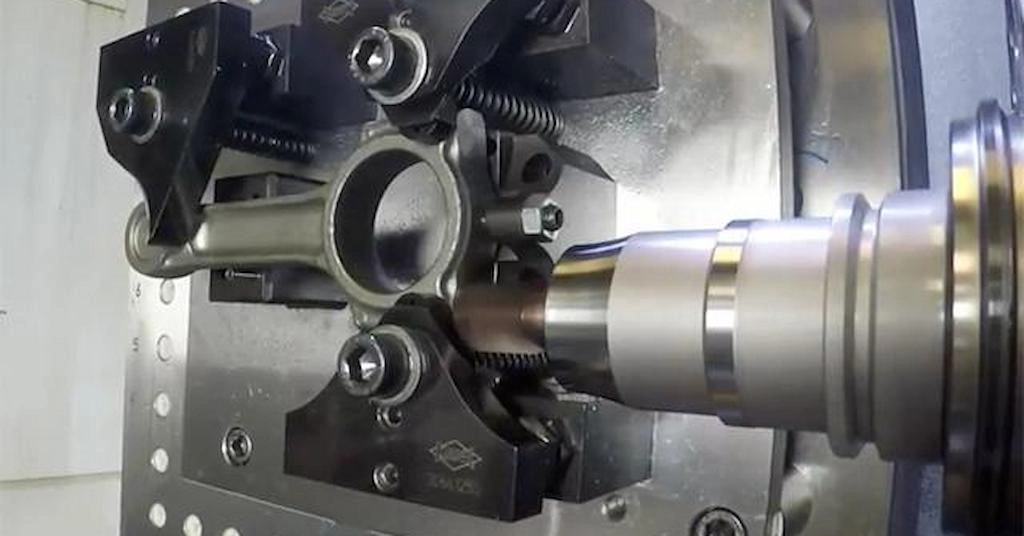
Connecting rod machining
This method uses computer codes to precisely cut the connecting rods into the desired shape from blocks of material. If you need tight tolerances and excellent repeatability, CNC is the best option. Furthermore, it is also cost-effective to make rod prototypes.
The precise tool movement allows for shaping the end bores accurately. CNC also provides a better finish than other methods.
- Die Casting
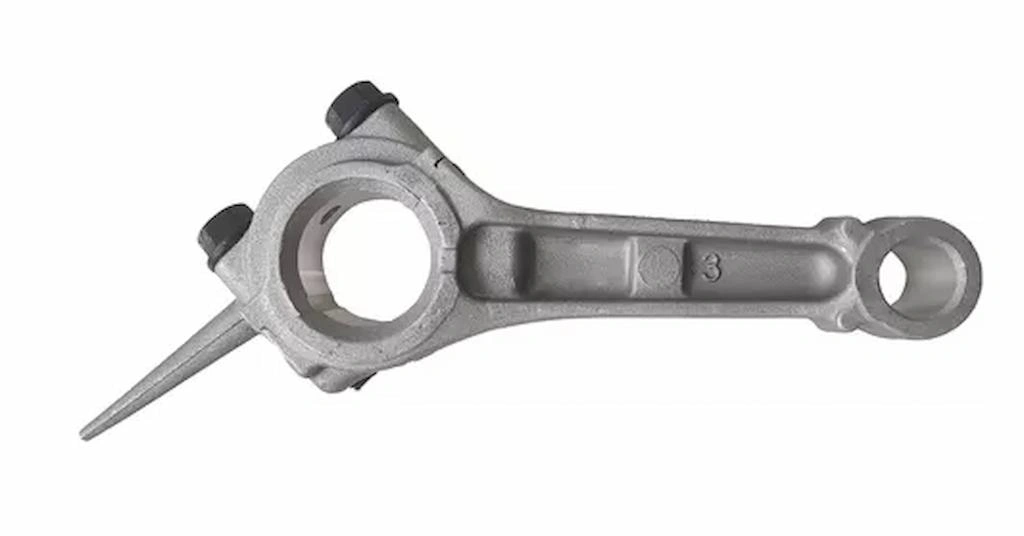
Die cast connecting rod
Typically, aluminum alloys are die cast into connecting rods, but sometimes other materials are also used. The process first involves making a die with a cavity, ensuring the cavity geometry is identical to the connecting rod exterior. Then, the molten metal is poured into the die cavity under high pressure, where it flows and captures the shape. Finally, the mold is opened to eject the connecting rod.
You can use this method for lightweight connecting rods for various needs, like fuel-efficient motorcycle engines. However, die-cast rods are not as strong as forged ones.
- Heat Treatment
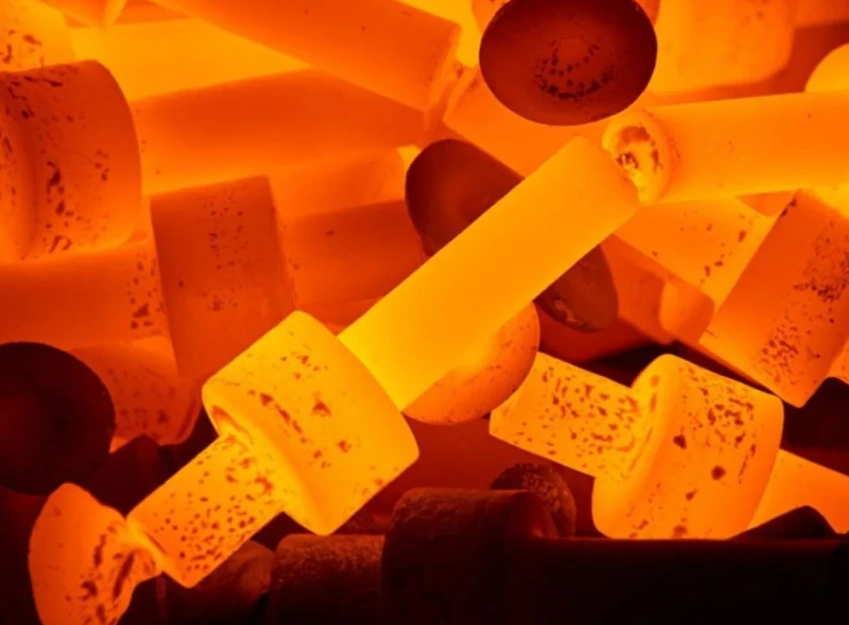
Heat Treatment Process
The heat treatment process alters the physical and mechanical properties by slightly changing the material’s microstructure. For connecting rods, quenching and tempering heat treatment are done to increase the hardness and strength.
Heat-treated connecting rods withstand higher mechanical and thermal stresses. They become more resistant to wear and cracking.
If you want to read about the manufacturing of other automotive components, click on CNC Machining for High-Performance Steering and CNC Machining for Classic & Vintage Car Parts here.
Connecting Rod Design Considerations
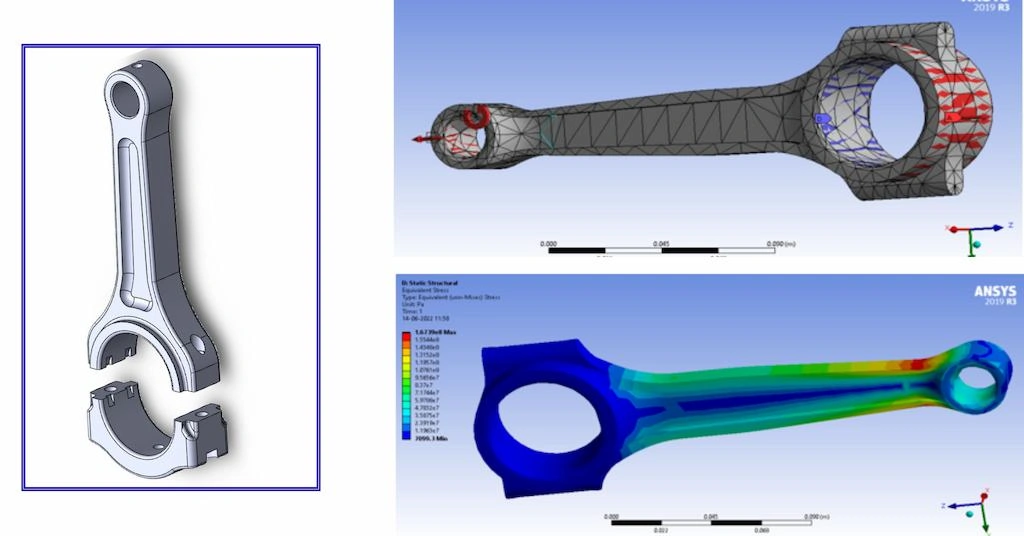
Connecting rod design
Design and its manufacturability are the primary requirements to produce accurate connecting rods. During this initial phase, you can customize shape, size, and features. A good design can also reduce the weight and improve durability.
The main considerations include load, strength, beam type, length to crank ratio, and friction, which are briefly elaborated below;
- Load Spectrum and Strength
The connecting rod undergoes cyclic stress, so ensure your design has structural integrity to withstand compressive and tensile loads over the long term. For this, you can perform Finite Element Analysis (FEA) for fatigue testing.
- Type of Beam
Based on your application requirements, choose I, H, or X-beam, whichever suits the desired strength-to-weight ratio. The rod should be able to sustain the thrust from the piston.
- Length to Crank Ratio
A larger length increases the weight of the connecting rod, which can limit engine speed. Therefore, you need to optimize the length-to-crank ratio. It is defined by the ratio of connecting rod length and crank throw. You can target this ratio between 3.5 to 4.5.
- Material Selection
Choosing the right material for the connecting rod not only ensures the desired functionality, but also plays a key role in weight reduction. For high-performance applications, you can choose Ti-6Al-4V.
- Friction
Consider friction in the joining points of connecting rods during designing. Ensure a good bearing design, finishing, and lubrication pathways to reduce the friction.
Conclusion
A connecting rod directly influences the operation, efficiency, reliability, and lifespan of any reciprocating engine. Understanding its structure & types, choosing the right material, careful manufacturing, and heat treatment ensure the desired characteristics in the connecting rod. You must be able to distinguish variations and features for optimal selection.
If you need further information regarding connecting rods and how to make them, you can Contact with our experts. We have a team of engineers and industry professionals with over a decade of experience in automotive manufacturing. They can help you with everything, from DFM optimizations and manufacturing to heat treatment. To start , you can upload your design and get a Fast & Free Quote .
FAQs
What does a connecting rod do?
It is a structural component in engines that links the piston and crankshaft for the conversion of linear motion into rotational motion.
What connects the piston to the crankshaft?
The piston is connected to the crankshaft via the connecting rod. The small end of the rod links the piston through the gudgeon pin.
What happens when a connecting rod goes bad?
A bad connecting rod provides signs like a knocking sound, low efficiency, and bearing noises. It should be replaced after this; otherwise, the engine compromises the performance or even causes failure.
How much does it cost to replace a connecting rod?
The cost of replacing a connecting rod depends on factors like size, function, and type of engine. For motorcycle engines, it can cost $50 to $300, whereas it can cost up to $2000+ for heavy-duty engines.
Is connecting rod and piston rod the same thing?
Although these two terms are used interchangeably in the latest IC engines, the piston rod is explicitly referred to more often in steam engines, compressors, and hydraulic cylinders.
Also Read:
What is a Camshaft: Key to Engine & Industry Success

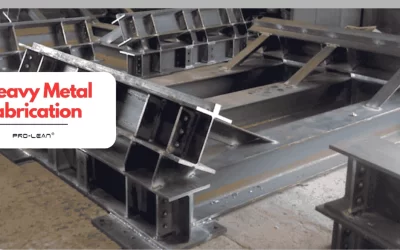
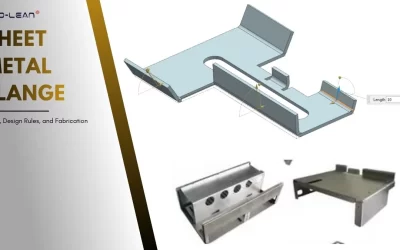
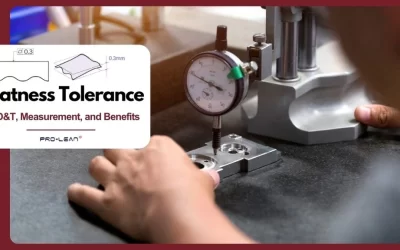
0 Comments